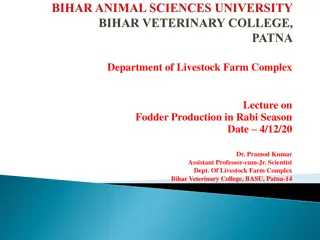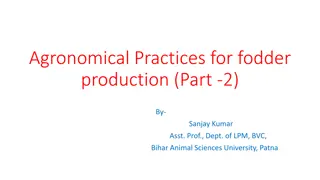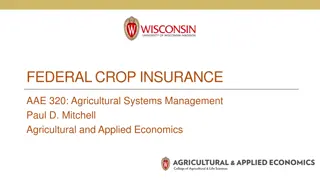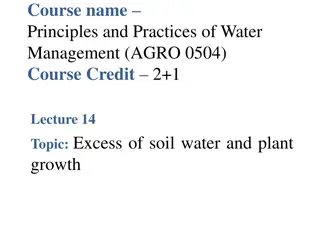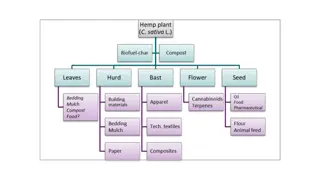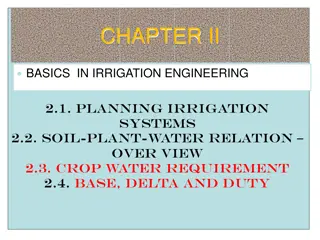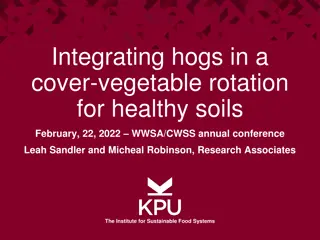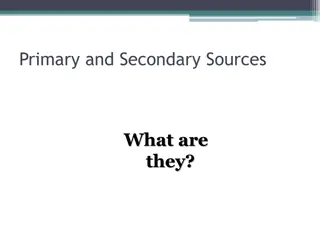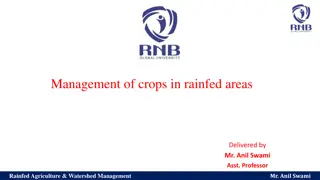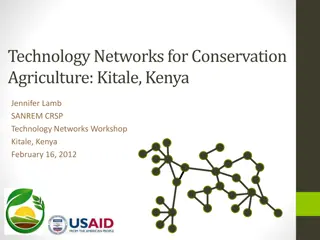Importance of Primary and Secondary Tillage in Crop Production
Tillage is a crucial operation in crop production involving primary and secondary stages. Primary tillage, such as ploughing, helps open compacted soil and uproot weeds, while secondary tillage refines the soil for better germination and growth. Various implements like ploughs, disc harrows, and cultivators are used in these processes. Understanding the principles and implications of tillage, choosing the right implements, and timing the operations correctly are key factors for successful crop production.
Download Presentation

Please find below an Image/Link to download the presentation.
The content on the website is provided AS IS for your information and personal use only. It may not be sold, licensed, or shared on other websites without obtaining consent from the author. Download presentation by click this link. If you encounter any issues during the download, it is possible that the publisher has removed the file from their server.
E N D
Presentation Transcript
Next End
Tillage is the first and the most important operation in crop production. Tillage operations are generally carried out before sowing or planting. Primary tillage is otherwise called as ploughing which is opening of compact soil with tools and implements. According to the need, different ploughs such as mould board, disc and country ploughs are chosen. Major primary tillage implements used are wooden ploughs (country plough), soil inversion ploughs (mould board, disc and turn-wrest) and special ploughs (Sub-soil plough, chisel plough, ridge plough, rotary plough or rotary hoes and basic lister). Finer operations are performed on the soil after primary tillage is known as secondary tillage. Disc harrows, cultivators, blade harrows etc., are used for this purpose. Different types of implements like cultivators, harrows, plank and rollers are used for secondary tillage. After the field preparation (through primary and secondary tillages), the field modifications are to be made to ease irrigation and sowing or planting. These operations are crop specific. Next Previous End
To study the primary and secondary tillage principles and their implications in crop production. To learn the different primary and secondary tillage implements and their possible usage and limitations in field condition. Introduction: Tillage is the physical or mechanical manipulation of the soil with tools and implements result in good tilth for better germination and subsequent growth of crops. Tillage needs to be done at the right time with the right implements to get good tilth, which is pre-requisite for better crop production. Tillage process is generally accomplished in two stages, namely, primary and secondary tillages. Layout for seedbed preparation is also inseparable process with tillage, a practice made before sowing or planting of crop. Next Previous End
Primary Tillage Primary tillage or ploughing is opening of the compacted soil with the help of different tools and implements preferably by ploughs. Ploughing is done mainly to open the hard soil. In addition, primary tillage also aims to inversion (whenever necessary) of soil, uprooting of weeds and stubbles. Deep tillage, sub-soiling and year round tillage are some of the types of primary tillages. Next Previous End
Depending on the purpose, soil condition and nature of weed problem, different ploughs are used (Table ). Table. Suitable ploughs for different situations Plough Situation or purpose Mould board plough (Animal drawn) Incorporation of manures, fertilizers and plant residue Mould board plough (Tractor drawn) Deep ploughing and inversion Disc plough, country plough Cutting of creeping or spreading grass and inversion Next Previous End
The right time for ploughing depends on availability of soil moisture. When the soil is too dry, it is difficult to open the soil, more energy is required and large sized clods are resulted. When the soil is ploughed under wet conditions, with more soil moisture, the soil sticks to the plough, the soil below the plough-sole becomes compacted. Upon drying, hard pan is created, soil structure is destroyed and the clods on drying become very hard. The optimum range of soil moisture for better ploughing is 25 to 50% depletion of available soil moisture. Light soils can be ploughed at wider range of soil moisture conditions, while; the range is narrow for heavy soils. Next Previous End
Depth of ploughing mainly depends on the effective root zone depth of the crops. Generally, crops with tap root system require greater depth of ploughing, while fibrous and shallow rooted crops require shallow ploughing. Tree crops are needed deeper soil ploughing whereas; field crops generally needed only shallow tillage. Number of ploughing The number of ploughing necessary to obtain a good tilth depends on soil type, weed problem and crop residues on the soil surface. In heavy soils, more (3-5) number of ploughing is necessary, but, light soils require 1 to 3 ploughing to obtain good tilth of the soil. When weed growth and plant residues are higher, more number of ploughing is necessary. Next Previous End
Depending on the purpose or necessity, different types of tillage are carried out. They are Deep ploughing Sub soiling and Year-round tillage. Next Previous End
One foot of surface soil over one hectare of land area approximately weighs about 5000 tonnes. Therefore, to plough deeper, enormous amount of energy is required. In western countries, deep ploughing of 50 cm depth for rainfed conditions and 70 cm for irrigated conditions is practiced. Ploughing of 5-6 cm depth is classified as shallow, 15-20 cm depth as medium deep and 25-30 cm depth as deep ploughing. Deep tillage is necessary for tap rooted crop like redgram and perennial crops, while, moderate deep tillage is preferred for fibrous rooted crops like maize and sorghum. Deep ploughing results large sized clods, which are scorched by the hot sun when it is carried out in summer. Next Previous (Cont).. End
These clods crumble due to alternate heating and cooling and also due to occasional summer showers and process of gradual disintegration of clods improves soil structure. The rhizomes and tubers of perennial weeds viz., Cynodon dactylon and Cyperus rotundus die due to exposure to hot sun. Summer ploughing reduces pest incidences by exposing pupae to hot sun. Deep tillage also improves soil moisture content by retaining more moisture during rainy period. However, the advantage of deep tillage in dry farming areas may not be assured and depends on rainfall pattern and crop. Next Previous End
Tillage operations carried out throughout the year are known as year round tillage. In dry farming regions, field preparation is initiated with the help of summer showers. Repeated tillage operations are carried out until sowing of the crop. Even after harvest of the crop, the field is repeatedly ploughed or harrowed to avoid weed growth during the off season. Next Previous End
Ploughs are commonly used for primary tillage. Implements used for opening and loosening of the soil are known as ploughs. Ploughs are of three types: Wooden ploughs Iron or inversion ploughs and Special purpose ploughs. Next Previous End
Wooden or Indigenous plough is an implement which is made of wood with an iron share point. It is drawn only with bullocks. It cuts a V shaped furrow and opens the soil, but no inversion is made due to country ploughs. Ploughing operation is also not perfect because some un-ploughed strip (of inverted shape) is always left between furrows. This can be reduced by cross ploughing, but even then, small squares remain un-ploughed. (Cont).. Next Previous End
Depending on the size and purpose, three types of wooden ploughs are distinguished. Heavy plough disturbs soil to a depth of 15 to 20 cm and is drawn by 3 to 4 pairs of cattle. They are also called as black soil ploughs and cover 0.10 to 0.15 ha in a day. Dryland plough is smaller than heavy plough and varies in size with the soil type. It covers an area of 0.15 to 0.25 ha in a day. Wetland plough is the smallest of the wooden ploughs. A worn-out dry land plough is used as a wetland plough. It ordinarily covers about 0.1 ha in a day for the first puddling and about 0.25 ha at further puddling. Next Previous End
Soil inversion or turning ploughs are made of iron and drawn by a pair or two pairs of bullocks depending on the type of soil. These are also drawn by tractors. Mould board plough This type of plough leaves no un- ploughed land as the furrow slices, cuts clean and inverted to one side resulting in better pulverization. The animal drawn mould board plough is small, plough to a depth of 15 cm. Victory plough is an animal drawn mould board plough with a short shaft. Two mould board ploughs of bigger in size are attached to the tractor and ploughed to a depth of 25 to 30 cm. Mould board ploughs are used for soil inversion. Next Previous End
The disc plough is having little resemblance to the common mould board plough. A large, revolving, concave steel disc replaces the share and the mould board. The disc turns the furrow slice to one side with a scooping action. The usual size of the disc is 60 cm in diameter and this turns a 35 to 30 cm furrow slice. The disc plough is more suitable for land with much fibrous growth of weeds, as the disc cuts and incorporates the weeds. The disc plough works well in soils free from stones. Next Previous End
The plough bottom of the plough is hinged to the beam such that the mould board and the share can be reversed to the left or to the right side of the beam. This adjustment saves the trouble of turning the plough in hilly tracts. c. Special ploughs Sub-soil plough The subsoil plough is designed to break up hard layers or pans without bringing them to the surface. The body of the subsoil plough is wedge shaped and narrow. The share of subsoil plough is wide so as to shatter the hard pan and making only a slot on the top layers. Next Previous End
It is mainly used for breaking hard pans and for deep ploughing (60-70 cm) with fewer disturbances to the top layers. Its body is thin with replaceable cutting edge, have minimum disturbance to the top layers. It contains a replaceable share to shatter at the lower layers. Next Previous End
This plough has two mould boards, one for turning the soil to the right and another to the left. The share is common for both the mould boards i.e. double winged. These mould boards are mounted on a common body. The ridge plough is used to split the field into ridges and furrows and for earthing up of crops like sugarcane, cotton etc. Ridge ploughs are used to make broad-bed and furrows by attaching two-ridge ploughs on a frame at 150 cm spacing between them. Animal drawn Ridge plough (Source: http://agritech.tnau.ac.in/agriculture /millets_maize.html) Next Previous End
It cuts the soil and pulverizes. The cutting of soil is done by either blades or tynes. The blade types are widely used. The depth of cut is up to 12 to 15 cm. Rotary plough is more suitable for light soils. Basic lister The basin lister is a heavy implement with one or two mould boards or shovels. These shovels are mounted on a special type of frame on which they act alternately. This implement is used to form listed furrows (broken furrows with small dams and basins) to prevent free runoff of rainfall and blowing-off the soil in low rainfall areas. Next Previous End
Lighter or finer operations performed on the soil after primary tillage is known as secondary tillage. After ploughing, the fields are left with large clods with some weeds and partially uprooted stubbles. Harrowing is to be done to a shallow depth to crush the clods and to uproot the remaining weeds and stubbles. Disc harrows, cultivators, blade harrows etc., are commonly used for this purpose. Planking is done to crush the hard clods to smoothen surface soil and to compact the soil lightly. Thus, the field can be made ready for sowing after ploughing by harrowing and planking. Sowing operations are also combined with secondary tillage. Secondary tillage implements Different types of implements like cultivators, harrows, plank and rollers are used for secondary tillage. Next Previous End
Cultivator is an implement used for finer operations like breaking clods and working the soil to a fine tilth for preparing seedbed. Cultivator is also called as tiller or tooth harrow. It is used to further loosen the previously ploughed land before sowing. It is also used to destroy weeds that germinate after ploughing. The main object of providing two rows and staggering the position of tynes is to provide clearance between tynes so that clods and plant residues can freely pass through without blocking. The number of tynes ranges from 7 to 13. The shares of the tynes can be replaced when they are worn-out. Next Previous End
In stubble-mulch farming, it is difficult to prepare the land with ordinary implements due to clogging and sweep cultivator is the implements useful under this condition. It consists of large inverted V shaped blades attached to a cultivator frame. These blades run parallel to soil surface at a depth of 10 to 15 cm. They are arranged in two rows and staggered. Sweep cultivator is used to cut to a depth of 12 to 15 cm soil during the first operation and still shallower during subsequent operations. It is worked frequently to control weeds. It is also used for harvesting groundnut in many parts of the world. Next Previous End
Harrows are used for shallow cultivation in operations such as preparation of seedbed, covering seeds and destroying weed seedlings. Harrows are of two types Disc harrow Blade harrow Next Previous End
The disc harrow consists of a number of concave discs of 45 to 55 cm in diameter. The discs cut through the soil and effectively pulverize the clods. Blade harrows are used for different purposes like removal of weeds and stubbles, crushing of clods, working of soil to shallow depth, covering the seeds, inter-cultivation and harvesting of groundnut etc. Disc harrow (Source: http://agriculture.indiabizclub.com/products/off set_disc_harrows) Next Previous End
Plank is a very simple implement and consists of a heavy wooden beam of 2 m in length. In addition, shafts and handle are fixed to the beams. When it is worked, most of the clods are crushed due to its weight. It also helps in micro-leveling and slight compaction necessary after sowing. Rollers are used mainly to crush the hard clods and to compact the soil in seed rows. Next Previous End
After the field preparation (through primary and secondary tillages), the field is to be laid out properly for irrigation and sowing (of seeds) or planting (of seedlings). These operations are crop specific. For most of the crops like wheat, soybean, pearl millet, groundnut, castor etc., flat leveled seedbed is mandatory. After the secondary tillage, these crops are sown without any land treatments or by forming beds and channels. However, growing crops during rainy season in deep black soils is a problem due to ill-drained conditions and as tillage is not possible during the rainy season. Broad-bed and furrows (BBF) are, therefore, formed before the onset of monsoon and dry sowing is carried out. Next Previous End
Some crops like maize, vegetables etc., need field lay out in ridges and furrows. Sugarcane is planted in the furrows or trenches. Crops like tobacco, tomato, chillies are planted with equal inter-and intra row spacing so as to facilitate two-way inter- cultivation. After field preparation, a marker is run in both the directions. The seedlings are transplanted at the intercepts. Setline planting is adopted in Gujarat, India for sowing cotton and groundnut. Every year, seed rows are in the same place, since the seed lines are set permanently at wider spacing. The inter-row space is not cultivated. This method of sowing reduces tillage, conserves moisture in seed rows and increases fertilizer use efficiency. After field preparation, sowing is done with seed drills. These seeds are covered by running blade harrow to a shallow depth followed by planking so as to level and impart necessary compaction. Next Previous End
Country plough and ridge ploughs are used for laying out the field into ridges and furrows or to lay out irrigation channels. Ridge ploughs, when attached to a frame can be used for making broad bed and furrows. Bunds for irrigation in the garden lands are made usually by manual labour using spades. Bunds are also formed across the contours in the low rainfall regions to conserve soil moisture. The small bund former is driven by a pair of cattle, whereas, bigger ones are mounted with tractors. Marker is used to mark intercepts for transplanting seedlings by square planting method. It consists of a beam to which 3 or 4 wooden tynes are fixed and spacing of tynes depends on the spacing the crop. When it is run in two directions, very shallow furrow markings are formed in two directions. Seedlings are transplanted at the intercepts. Previous Next End
Tillage is the physical or mechanical manipulation of the soil with tools and implements to get good tilth for growing of crops. Tillage includes primary and secondary tillages and lay-out of seedbed preparation. Primary tillage is generally done to open the hard soil, inversion (whenever necessary) of soil, uprooting of weeds and stubbles. Success of the primary tillage mainly governed by depth, time, selection of ploughs and number of ploughs. Three major types of primary tillage are Deep tillage, Sub-soiling tillage and Year-round tillage Previous Next (Cont).. End
Implements largely used for primary tillage are wooden plough or indigenous plough, Soil inversion ploughs (mould board, disc and turn-wrest ploughs) and special ploughs (sub-soil, chisel plough, ridge plough and rotary ploughs and basic lister). Lighter or finer operations performed on the soil after primary tillage is known as secondary tillage. Secondary tillage implements used are tractor drawn cultivator, sweep cultivator, harrows, plank and roller. After the field preparation through primary and secondary tillages, the field is to be laid out properly for irrigation and sowing or planting seedlings. Country plough, ridge plough and marker are important implements used for seedbed preparation. (cont).. Next Previous End
Tillage is the physical or mechanical manipulation of the soil with tools and implements (True/False). Deep tillage, sub-soiling and year round tillage are primary tillages (True/False). Optimum range of soil moisture for effective ploughing is 25 to 50% depletion of available soil moisture (True/False). Crops with fibrous root system require greater depth of ploughing, while tap rooted crops require shallow ploughing (True/False). In heavy soils, more number of ploughing is necessary, but, light soils require lesser ploughing to get good tilth (True/False). Deep tillage improves soil moisture content by retaining more moisture during rainy period (True/False). (Cont).. Next Previous End
Mould board plough is more suitable for land with much fibrous growth of weeds (True/False). Chisel plough is used for breaking hard pans and for deep ploughing with fewer disturbances to the top layers (True/False). The ridge plough is used to split the field into ridges and furrows and for earthing up of crops (True/False). Lighter or finer operations performed on the soil after primary tillage is known as secondary tillage (True/False). Crops like maize, vegetables etc., need field is to be laid out into ridges and furrows (True/False). Next Previous End
Rajendra Prasad, 1999. A text book of Rice Agronomy. Jain Brothers, New Delhi. Nakra, C.P. 1980. Farm machinery and equipments. Dhanpati Rai and Sons, New Delhi. Yellamanda Reddy, T. and Sankara Reddi, G.H. 1995. Principles of Agronomy. Kalyani Publisher, Ludhiana. Next Previous End






